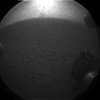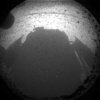- Joined
- Jan 20, 2004
- Location
- Saltirelandia
Curiosity, NASA's Mars mission, just completed entry, descend and and a very ballsy landing! Pictures of the afternoon sun are coming back. All good! Nice job guys!
See an infographic on the EDL sequence
FTR, these are the three major Mars vehicles to date compared side-by-side, the big one on the right -- the size of a compact car, weighs about a ton! -- is Curiosity. If you're wondering why there are no solar panels it's because it doesn't have any, instead it has its own little [strike]nuclear reactor[/strike] plutonium battery on board.

The first picture back from Curiosity, it's wheel on the surface just moments after touchdown:

And this is Curiosity's first high res picture, it's shadow on the surface:

See an infographic on the EDL sequence
You do not have permission to view link
Log in or register now.
. It all took about 7 minutes, crazy fast!FTR, these are the three major Mars vehicles to date compared side-by-side, the big one on the right -- the size of a compact car, weighs about a ton! -- is Curiosity. If you're wondering why there are no solar panels it's because it doesn't have any, instead it has its own little [strike]nuclear reactor[/strike] plutonium battery on board.

The first picture back from Curiosity, it's wheel on the surface just moments after touchdown:

And this is Curiosity's first high res picture, it's shadow on the surface:

Last edited:

 .......
.......


 completely entertained me!
completely entertained me!